Have you ever wandered through a garden and been captivated by the sight of towering, blue delphinium flowers swaying gently in the breeze? These majestic blooms, with their serene hues and striking presence, have a way of evoking a sense of wonder and tranquility. Whether you’re a seasoned gardener, a floral designer, or simply someone who appreciates the beauty of nature, blue delphiniums are a flower worth knowing more about. In this article, we’ll dive deep into 7 stunning facts about blue delphinium, explore their history, growing conditions, and unique characteristics, and answer all the questions you might have about this captivating bloom.
Table of Contents
1. The Symbolism and Emotional Appeal of Light Blue Delphinium
A Flower with Deep Meaning
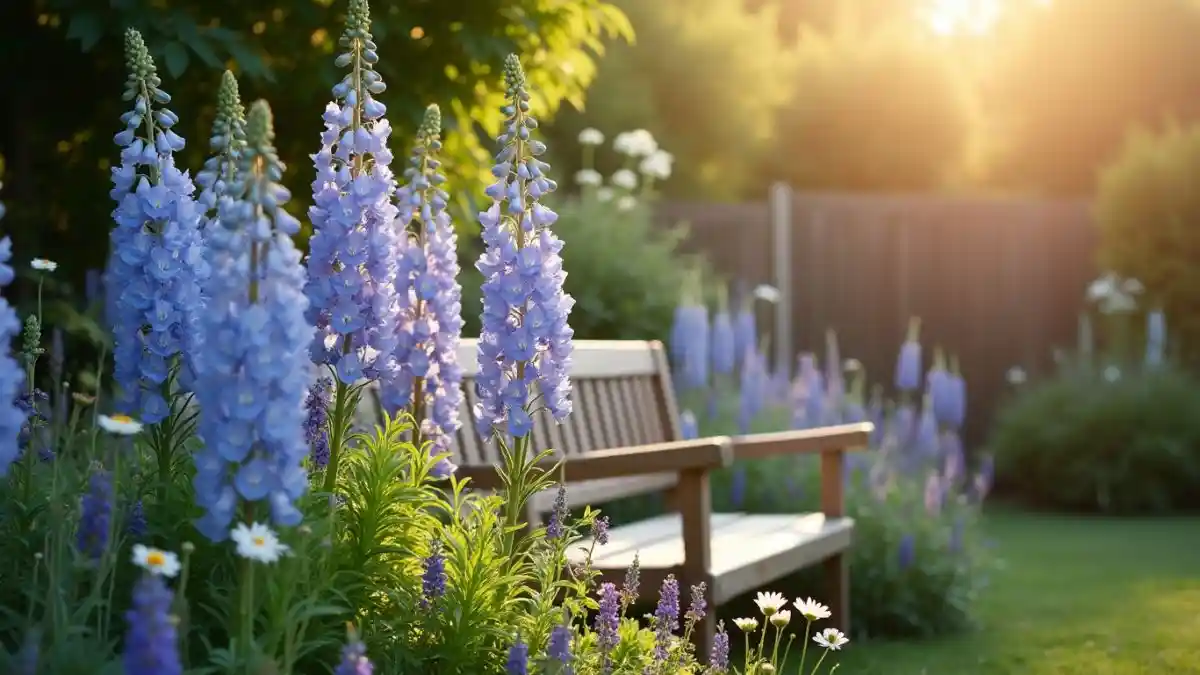
Blue delphiniums are more than just a pretty face in the garden. They symbolize dignity, grace, and positivity, making them a popular choice for weddings, anniversaries, and other special occasions. In the language of flowers, they convey a sense of tranquility and open-heartedness, often representing new beginnings and heartfelt emotions.
Historically, delphiniums have roots in Greek mythology, where they were believed to have sprung from the blood of Ajax, a hero of the Trojan War. This rich symbolism adds depth to their beauty, making them a meaningful addition to any garden or floral arrangement.
Emotional Connection
The color blue is universally associated with calmness and serenity, and blue delphiniums are no exception. Their soft, soothing hues can transform any space into a peaceful retreat. Imagine sitting in your garden, surrounded by these ethereal blooms, feeling the stresses of the day melt away. It’s no wonder they’re a favorite among gardeners and flower enthusiasts alike.
2. The Unique Anatomy of Light Blue Delphinium
Towering Beauty
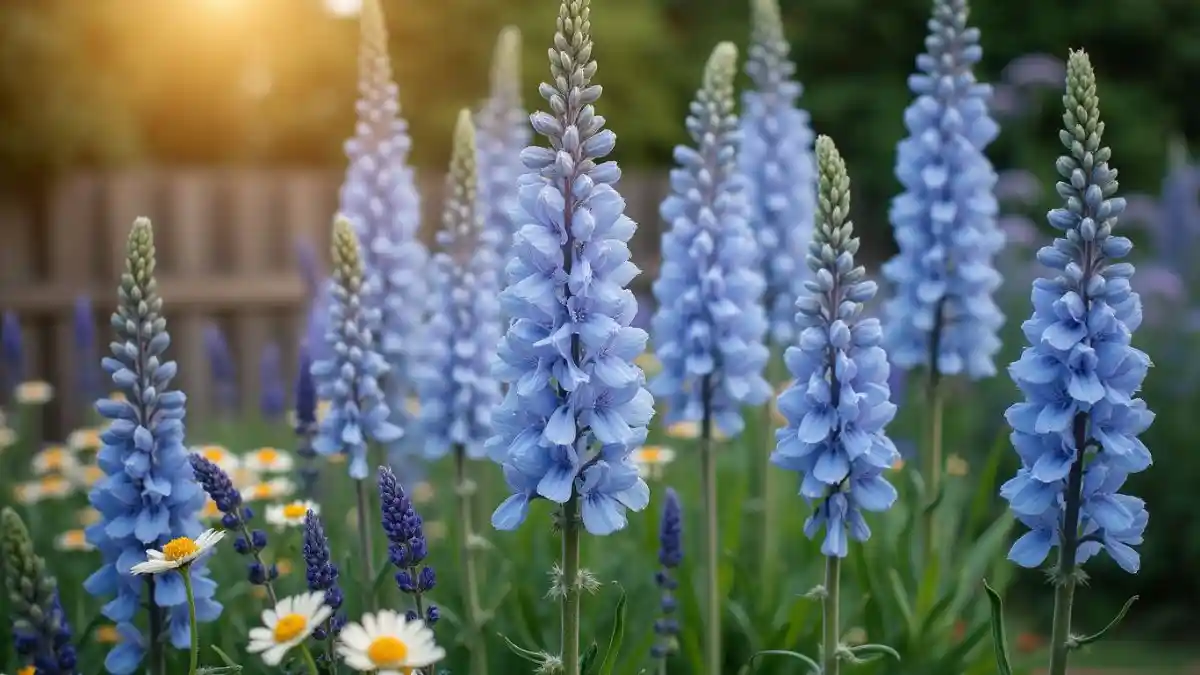
One of the most striking features of blue delphiniums is their impressive height. These flowers can grow up to 6 feet tall, creating a dramatic vertical display that adds depth and dimension to any garden. Their flower spikes are composed of multiple florets, each contributing to the overall grandeur of the plant.
Color Variations and Patterns
Blue delphiniums often feature a contrasting “bee” (the center of the floret) in white or dark blue, adding to their visual appeal. This subtle yet striking detail makes them a standout in any floral arrangement or garden bed.
Here’s a quick comparison of popular blue delphinium varieties:
| Variety | Height | Bloom Color | Special Features |
| Pacific Giants | 5-6 ft | Light blue with white bee | Large, showy blooms |
| Blue Bird | 4-5 ft | Light blue with dark blue bee | Compact growth, ideal for borders |
| Guardian Blue | 5-6 ft | Light blue with white bee | Disease-resistant, long-lasting |
3. The Ideal Growing Conditions for Light Blue Delphinium
Climate and Soil Requirements
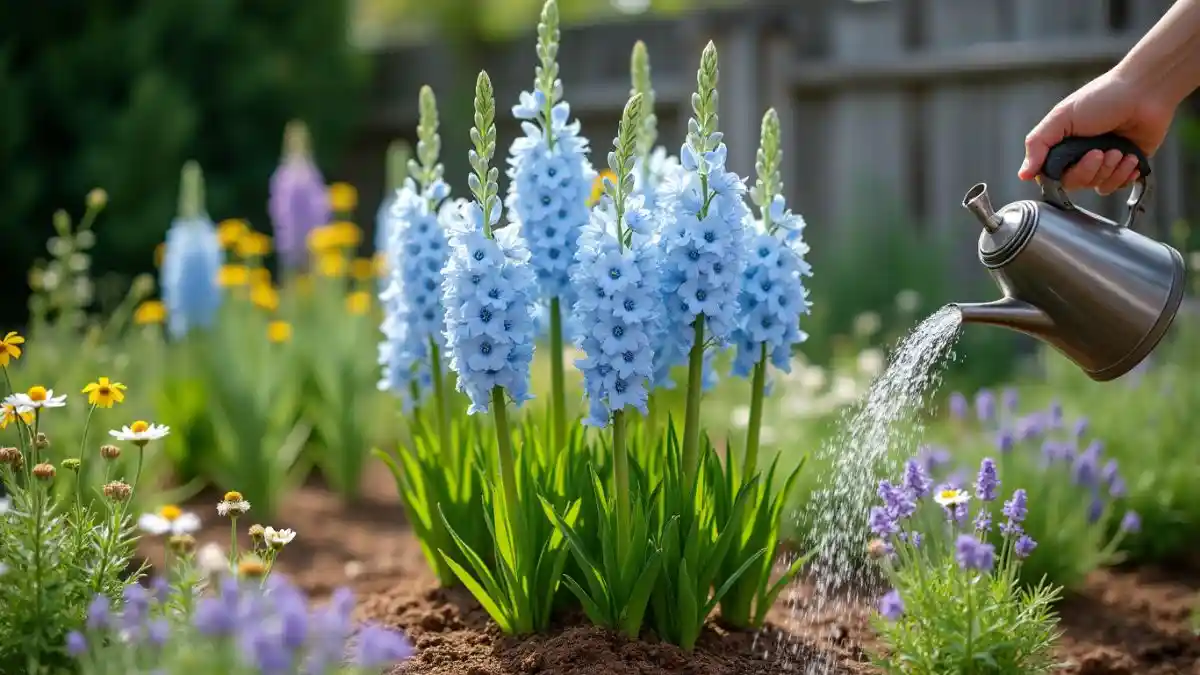
Blue delphiniums thrive in cool climates with well-drained, fertile soil. They prefer full sun but benefit from afternoon shade in hotter regions to prevent wilting. If you live in a warmer area, consider planting them in a spot that gets morning sun and afternoon shade.
Planting and Maintenance Tips
Here’s a step-by-step guide to planting and caring for blue delphiniums:
- Choose the Right Location: Select a spot with good air circulation to prevent fungal diseases.
- Prepare the Soil: Amend the soil with compost or organic matter to ensure it’s rich and well-draining.
- Plant Carefully: Space the plants about 2-3 feet apart to allow for growth.
- Water Consistently: Keep the soil moist but avoid waterlogging, as delphiniums are prone to root rot.
- Stake Tall Varieties: Use stakes or supports to prevent the tall flower spikes from toppling over.
Seasonal Care
- Spring: Fertilize the plants and stake them to support growth.
- During summer, remove faded flowers to promote a second round of blooming.
- Fall: Cut back the plants and mulch to protect the roots during winter.
4. The Role of Light Blue Delphinium in Pollinator Gardens
A Magnet for Bees and Butterflies
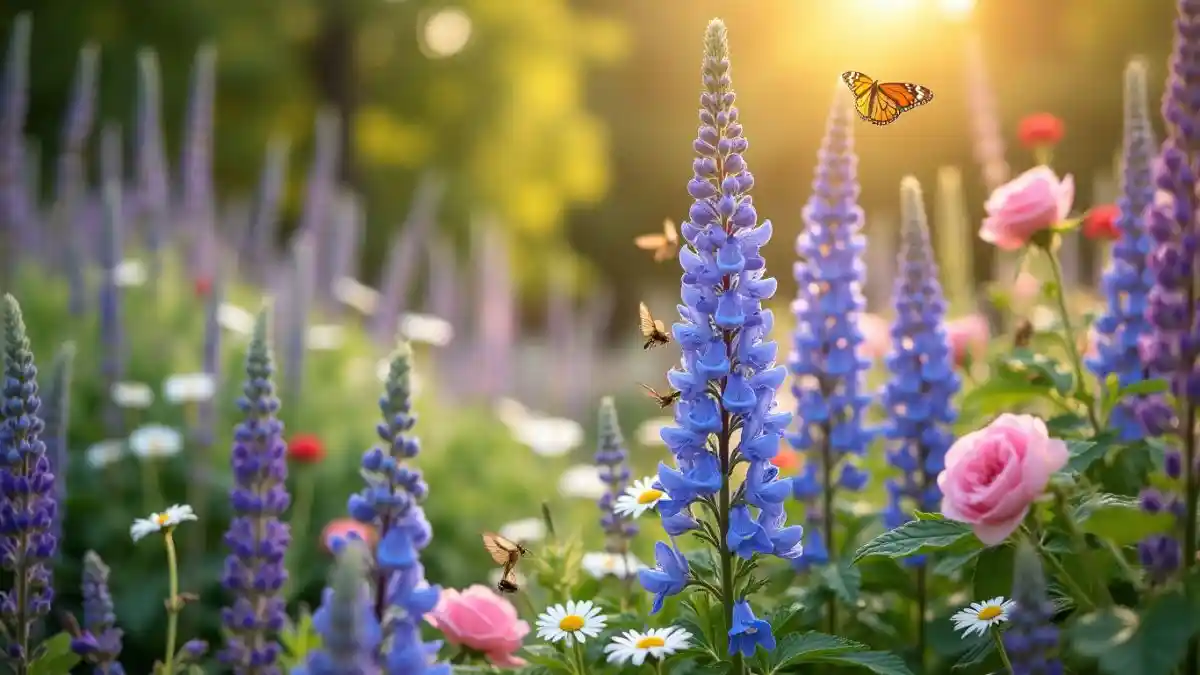
Delphinium flowers blue are a favorite among pollinators due to their nectar-rich flowers. By planting them in your garden, you’re not only adding beauty but also supporting local ecosystems and promoting biodiversity.
Companion Planting Ideas
Pairing blue delphinium flowers with other plants can enhance their growth and visual appeal. Here are some great companion plants:
- Roses: Their contrasting colors create a stunning display.
- Lavender: Adds fragrance and attracts even more pollinators.
- Daisies: Provide a cheerful, cottage-garden feel.
5. The History and Origin of Blue Delphinium
A Flower with Ancient Roots
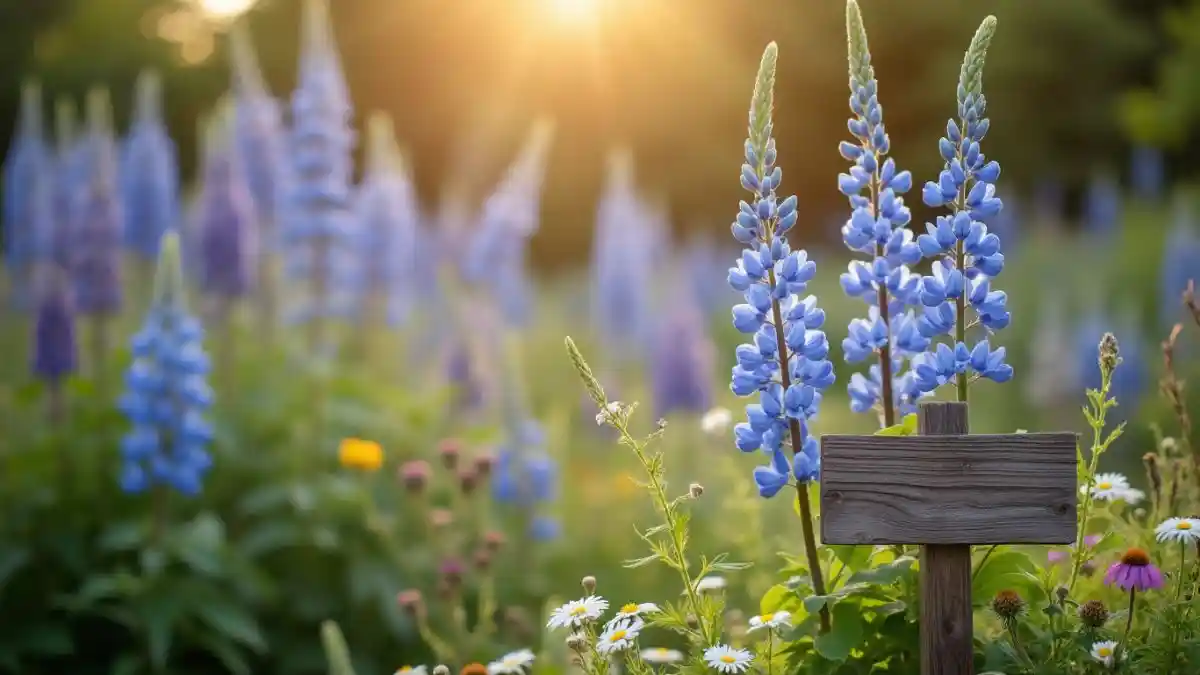
Delphiniums have been cultivated for centuries, with origins in Europe and Asia. They were used in traditional medicine and folklore, often believed to have healing properties.
Modern Cultivation
Today, hybridization has led to the development of stunning flowers light blue varieties. Breeders like Luther Burbank have played a significant role in popularizing these blooms, making them a staple in gardens worldwide.
6. Light Blue Delphinium in Floral Arrangements
A Florist’s Favorite
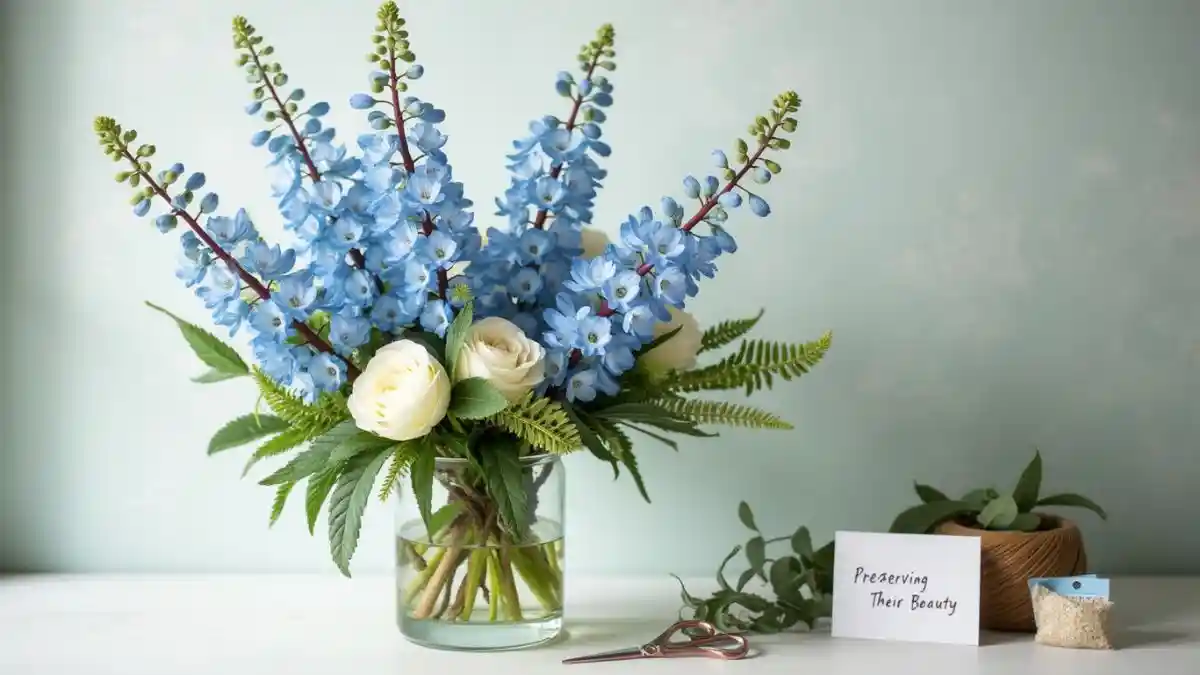
Their tall, elegant spikes make blue delphiniums ideal for centerpieces, bouquets, and wedding arrangements. Pair them with white roses or greenery for a classic, timeless look.
Preserving Their Beauty
To keep cut delphiniums fresh longer:
- Trim the stems at an angle.
- Use flower food in the water.
- Keep them out of direct sunlight and away from heat sources.
7. Fun and Lesser-Known Facts About Blue Delphinium
Did You Know?
- Delphiniums are also known as “larkspur,” though there are slight botanical differences.
- The term “delphinium” originates from the Greek word “delphis,” which means dolphin, referencing the dolphin-like shape of the flower buds.
- Light blue delphiniums are often used in cottage garden designs for their romantic appeal.
Conclusion
Blue delphiniums are more than just a pretty face in the garden; they are a symbol of elegance, a haven for pollinators, and a flower steeped in history and meaning. Whether you’re looking to add a touch of serenity to your garden or create a show-stopping floral arrangement, these stunning blooms are sure to leave a lasting impression. So why not plant some blue delphiniums and let their beauty transform your space?
FAQ Section
What does the light blue delphinium symbolize?
Blue delphiniums symbolize dignity, grace, and positivity, making them perfect for special occasions.
How tall can light blue delphiniums grow?
They can reach heights of up to 6 feet, creating a dramatic vertical display in gardens.
Are light blue delphiniums difficult to grow?
While they require specific conditions (cool climate, well-drained soil), with proper care, they can thrive beautifully.
Can light blue delphiniums attract pollinators?
Yes, their nectar-rich flowers are a favorite among bees and butterflies.
How do I keep cut light blue delphiniums fresh?
Trim the stems, use flower food, and keep them away from direct sunlight to prolong their freshness.
What are the best companion plants for light blue delphiniums?
Roses, lavender, daisies, and salvia are excellent companions.
How often should I water light blue delphiniums?
Maintain consistent watering, ensuring the soil stays moist without becoming overly saturated.
Can light blue delphiniums grow in hot climates?
They thrive in cooler climates but can also grow in warmer areas if provided with afternoon shade and sufficient watering.
Are light blue delphiniums toxic to pets?
Yes, they are toxic to dogs and cats if ingested, so keep them out of reach.
How do I prevent pests from damaging my light blue delphiniums?
Use organic pest control methods like neem oil or diatomaceous earth, and ensure good air circulation around plants.
By following this guide, you’ll not only enhance your garden with the beauty of blue delphiniums but also gain a deeper appreciation for their history, symbolism, and ecological benefits. Happy gardening!



1 thought on “7 Stunning Facts About Light Blue Delphinium You Must Know”